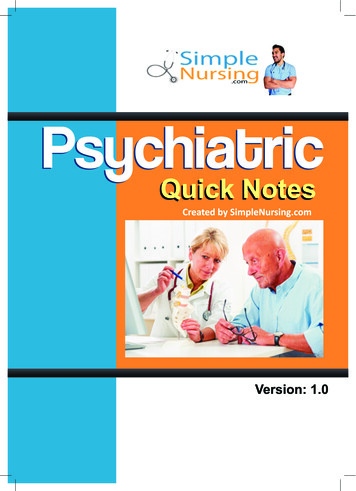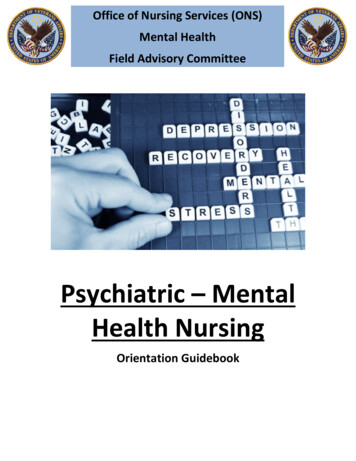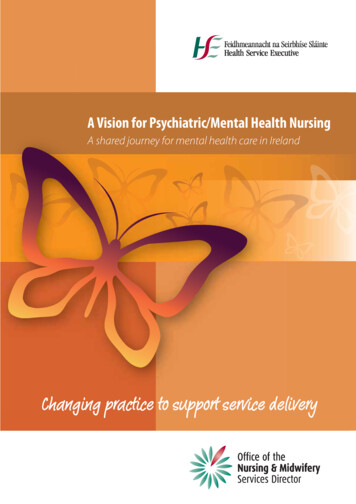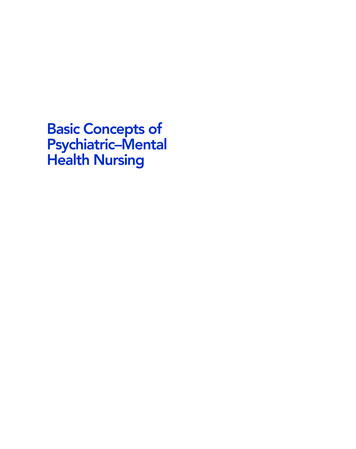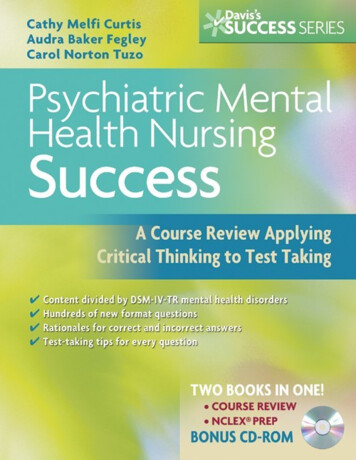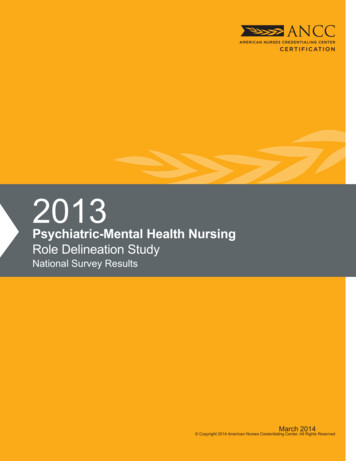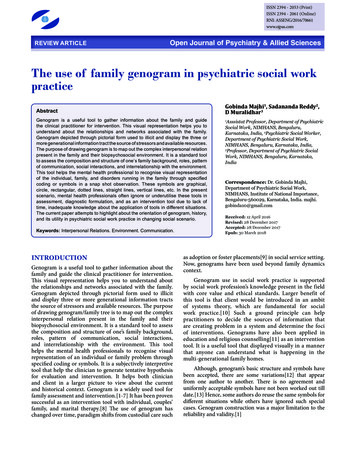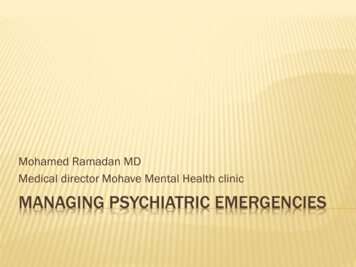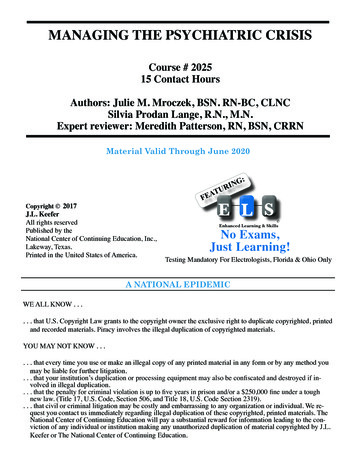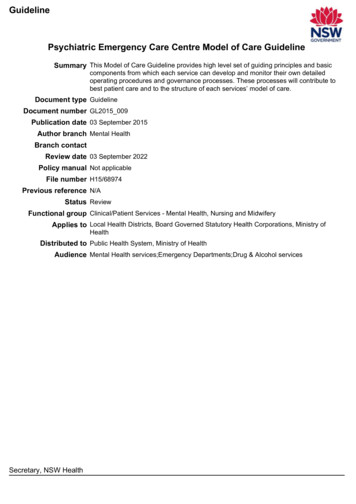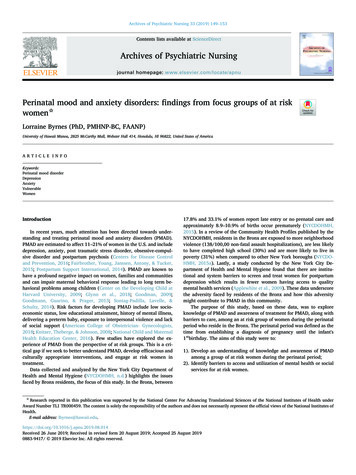
Transcription
Archives of Psychiatric Nursing 33 (2019) 149–153Contents lists available at ScienceDirectArchives of Psychiatric Nursingjournal homepage: www.elsevier.com/locate/apnuPerinatal mood and anxiety disorders: findings from focus groups of at riskwomen TLorraine Byrnes (PhD, PMHNP-BC, FAANP)University of Hawaii Manoa, 2825 McCarthy Mall, Webster Hall 414, Honolulu, HI 96822, United States of AmericaA R T I C LE I N FOKeywords:Perinatal mood onIn recent years, much attention has been directed towards understanding and treating perinatal mood and anxiety disorders (PMAD).PMAD are estimated to affect 11–21% of women in the U.S. and includedepression, anxiety, post traumatic stress disorder, obsessive-compulsive disorder and postpartum psychosis (Centers for Disease Controland Prevention, 2016; Fairbrother, Young, Janssen, Antony, & Tucker,2015; Postpartum Support International, 2014). PMAD are known tohave a profound negative impact on women, families and communitiesand can impair maternal behavioral response leading to long term behavioral problems among children (Center on the Developing Child atHarvard University, 2009; Glynn et al., 2018; Goodman, 2009;Goodmann, Guarino, & Prager, 2013; Sontag-Padilla, Lavelle, &Schultz, 2014). Risk factors for developing PMAD include low socioeconomic status, low educational attainment, history of mental illness,delivering a preterm baby, exposure to interpersonal violence and lackof social support (American College of Obstetrician- Gynecologists,2018; Knitzer, Theberge, & Johnson, 2008; National Child and MaternalHealth Education Center, 2016). Few studies have explored the experience of PMAD from the perspective of at risk groups. This is a critical gap if we seek to better understand PMAD, develop efficacious andculturally appropriate interventions, and engage at risk women intreatment.Data collected and analyzed by the New York City Department ofHealth and Mental Hygiene (NYCDOHMH, n.d.) highlights the issuesfaced by Bronx residents, the focus of this study. In the Bronx, between17.8% and 33.1% of women report late entry or no prenatal care andapproximately 8.9–10.9% of births occur prematurely (NYCDOHMH,2015). In a review of the Community Health Profiles published by theNYCDOHMH, residents in the Bronx are exposed to more neighborhoodviolence (138/100,00 non-fatal assault hospitalizations), are less likelyto have completed high school (30%) and are more likely to live inpoverty (31%) when compared to other New York boroughs (NYCDOHMH, 2015a). Lastly, a study conducted by the New York City Department of Health and Mental Hygiene found that there are institutional and system barriers to screen and treat women for postpartumdepression which results in fewer women having access to qualitymental health services (Applewhite et al., 2009). These data underscorethe adversity faced by residents of the Bronx and how this adversitymight contribute to PMAD in this community.The purpose of this study, based on these data, was to exploreknowledge of PMAD and awareness of treatment for PMAD, along withbarriers to care, among an at risk group of women during the perinatalperiod who reside in the Bronx. The perinatal period was defined as thetime from establishing a diagnosis of pregnancy until the infant's1stbirthday. The aims of this study were to:1). Develop an understanding of knowledge and awareness of PMADamong a group of at risk women during the perinatal period;2). Identify barriers to access and utilization of mental health or socialservices for at risk women. Research reported in this publication was supported by the National Center For Advancing Translational Sciences of the National Institutes of Health underAward Number TL1 TR000459. The content is solely the responsibility of the authors and does not necessarily represent the official views of the National Institutes ofHealth.E-mail address: 2019.08.014Received 26 June 2019; Received in revised form 20 August 2019; Accepted 25 August 20190883-9417/ 2019 Elsevier Inc. All rights reserved.Downloaded for Fran Byrd (fbyrd@nccnet.org) at National Certification Corporation from ClinicalKey.com/nursing by Elsevier on July 02, 2020.For personal use only. No other uses without permission. Copyright 2020. Elsevier Inc. All rights reserved.
Archives of Psychiatric Nursing 33 (2019) 149–153L. ByrnesMethodstotal of 24 participants overall. Both groups were audio recorded usinga digital recorder. A semi structured interview guide was developed toguide and prompt the participants. Each group began with the following question, “Please tell us what you know about depression, anxiety and other mental health problems that a woman may experienceduring pregnancy or after the birth of her baby.” Other prompts included, “Were you screened for depression or other problems duringyour pregnancy or after the baby was born?” “Did you feel you wereable to discuss any mental health problems that you might have experienced during your pregnancy or after the baby was born?” “Whatdid you feel was a barrier to accessing mental health services and whatfacilitated accessing mental health services?” “What services should beoffered to women in this community who might have depression, anxiety or another mental health problem?” The focus groups concludedwhen all at the table agreed that no new thoughts or comments wouldbe forthcoming. The first group was approximately 90 min and thesecond group was approximately 120 min.Conceptual frameworkCommunity based participatory research (CBPR) was chosen as theconceptual framework for the study. CBPR is defined as a collaborativeresearch method in which community members engage with researchers as equal partners with a shared interest (Faridi, Grunbaum,Gray, Franks, & Simoes, 2007). CBPR also offers a philosophical foundation to planning, designing and implementing studies in which theinvolvement of the community is not only needed but is essential to thesuccess of the study. The assumptions of CBPR include the following 1).Individuals and communities have rich knowledge of their lives andhow they are experienced; 2). Individuals maintain responsibilities andconnections to their communities; 3). We are complex organisms defined by social, political, and cultural systems in which power andprivilege play a role; 4).CBPR is grounded in truth, awareness, integrityand commitment. (Torres, 2009). This partnership was essential if thesystem and institutional barriers to accessing care were to be exploredwithin these groups. This study was the result of a discussion that occurred during a community engagement meeting hosted by the WeillCornell Clinical Translational Science Center. A community membervoiced concern over the lack of utilization of mental health servicesamong pregnant and postpartum women and requested help to explorethe issue.Data analysisEach focus group was audio recorded and transcribed verbatim. Thetranscripts were checked by the PI for accuracy. It should be noted thata few sentences were unintelligible in both groups but this ultimatelydid not impact the analysis. Qualitative content analysis using Kruegerand Casey's (2015) framework provided structure for analyzing focusgroup data. As a qualitative research method, content analysis guidesthe researcher in the interpretation of text data by utilizing a process ofcoding leading to identification of themes (Hsieh & Shannon, 2005).Framework analysis occurs as the data is being collected and emphasizes the process as non-linear. There are 5 interconnected stages toconducting framework analysis. The first is to assure the collection ofrich data by skillful planning, thorough note taking, and verbatimtranscription. The researcher then must immerse in the data by reviewing the audiotapes and reading the transcripts multiple times. Atthis point themes will begin to emerge. Written notes in the margins ofthe transcripts help this process along as concepts form. This is followedby indexing and charting in which participants' quotes are placed together as themes emerge. Mapping and interpretation are only possiblewhen the data has been reduced to this point. Dependability and consistency are assured by verbatim transcription and review and collection of sufficient data that is clearly documented (Lincoln & Guba,1985). Descriptive statistics were used to describe the demographiccharacteristics of the 2 groups.DesignFocus groups were convened to provide a forum for participants toshare what they knew about PMAD including risk factors for PMAD,symptoms, how diagnosis occurs, treatment available after diagnosis,and barriers to care. This knowledge sharing included exploring perceptions, opinions and attitudes about PMAD. In keeping with thefoundation of CBPR, recommendations were sought about PMADtreatment, cultural nuances, barriers to care and other important issuesnot addressed in the current literature or by community and health careproviders. The academic institutional review board approved the studyprior to participant recruitment.SampleParticipants were recruited using flyers posted in 2 communitycenters serving women during the perinatal period in the Bronx.Women were eligible to participate if they were between the ages of18–44, were either pregnant or had a live birth within the past year,and could participate in a focus group speaking English.ResultsThe focus group participants ranged from ages 18–42 with a meanage of 30.12 (standard deviation [SD] 6.95). Nineteen participantsreported a Hispanic/Latina? ethnicity (79%). Five reported a currentpregnancy (20%) and the remaining 19 women had at minimum 1 childage 1 or younger. The groups were racially diverse with five self described as African-American (20%), five self described as White (20%)and the remaining 14 participants self described as mixed race (58%).All participants completed high school. Nineteen reported being bilingual (English/Spanish) but had sufficient fluency to participate in thefocus group in English.ProcedureWomen were screened by telephone for study eligibility by a research assistant who was fluent in English and Spanish. If eligible thewoman was offered the opportunity to participate in one of twoscheduled focus groups. The focus groups were held at 2 different butlocal community centers to reduce transportation burden. If a potentialparticipant was ineligible an explanation was provided. The PI for thisstudy co- moderated the focus groups with a community member whoserved as an outreach worker to women during the perinatal period inthe Bronx. The research assistant attended the focus groups to assistparticipants with the consent process, setting up the recording equipment and distributing the incentive at the conclusion of the focus group.At the beginning of the focus group the PI discussed the importance ofmaintaining confidentiality for the ensuing discussion. The communitymember discussed having respectful consideration for what each participant brought to the group. A brief demographic survey was completed by each participant.Group one had 12 participants and group 2 had 12 participants for aKnowledge and awareness of PMADParticipants in both focus groups had an expansive knowledge andawareness of perinatal mood disorders and anxiety. Most, if not all,could identify common signs and symptoms including sadness, fatigue,anhedonia, irritability, excessive worry and difficulty with regulatingsleep and appetite. There was a great deal of interaction as participantsshared the following comments about PMAD: “not keeping up withyour appearance”, “isolating yourself because you're sad or150Downloaded for Fran Byrd (fbyrd@nccnet.org) at National Certification Corporation from ClinicalKey.com/nursing by Elsevier on July 02, 2020.For personal use only. No other uses without permission. Copyright 2020. Elsevier Inc. All rights reserved.
Archives of Psychiatric Nursing 33 (2019) 149–153L. Byrnesexpect me to answer although I don't really know them. Like am Ismoking, drinking or using drugs? I get it. It hurts the baby but ask me adifferent way, like you're thinking of me too. Anyway if I said yes thenthey call ACS” [Administration for Children Services]. Some of theparticipants shook their heads in agreement/show of support.Another participant recounted what transpired after she talkedabout feeling depressed, “They asked me a lot of questions and then toldme to see the social worker. They gave me a slip of paper to bring toher. I just didn't go. I don't trust them. I don't want them to take mybaby away from me”.Health care staff often screen for domestic violence and depressionat prenatal visits.One participant discussed her reaction to this screening, “The nurseshe asks questions like, ‘are you sad? Is the baby's daddy hurting you?’Kicking, punching, things like that. No, that is not happening to me butwhy would I tell YOU? (emphasized by respondent). I don't want ACScoming to my home”.Another participant described her experience, “No one asked me if Iwas depressed the first time. And I was the father had gotten arrestedthe day before I went into labor. Nobody asked me any questions. Imade like I was ok. I said I'm happy but, you know, I lied. I didn't wantthem to keep me in the hospital”.One participant recounted her disappointment with her care, “I hada big issue they refused to let me deliver in a certain hospital. I didn'thave an ACS case when I got there but when I left I did. They labeled mean ‘insignificant mother’ meaning I couldn't provide for my baby. Thathurts.” Participants expressed dismay and sadness when they heard thisand a few kept quietly repeating insignificant mother and shaking theirheads.The final participant stated poignantly, “I also, I feel like one of thereasons, honestly, I feel the statistics number is low, I think more momsactually go through it but it's in private. I feel the reason of that isbecause post-partum depression is basically painted in a negative light.So, a mother hears about post-partum depression she thinks, ‘Oh mygod, she's killing the baby’ or ‘I'm going to kill my baby.’ It's just paintedin a negative way. So instantly if the mom is going through that she'snot going to want to say anything because she might think that, peopleare going to call the cops or social services, so the mom feels she's notcapable of taking care of her child.”overwhelmed and you think you should be happy about the new babyso you try to keep to yourself”, “everyone is telling you things and youbegin to feel overwhelmed. If you weren't confident about the babybefore now you feel like you can't do anything right. That made mereally anxious.” There was awareness about the gravity of PMAD “Thisis serious. People snap everyone is not so strong that they can dealwith the stress of the new baby.” The participants agreed with the individual speakers by nodding their heads or verbalizing.A few participants provided more extreme examples that they personally experienced or witnessed. “I had impulses I didn't act on, thingsin my head thank God I never suffocated her or threw her out thewindow”. “She was premature and the father was always out. He gaveme money for the baby but he wasn't there. She (the baby) couldn'tsleep through the night and I yelled at her. I am not ashamed because Ididn't snap and abuse her but I never told anyone. If I told they wouldhave taken her away”. “You have a baby so that someone will love youbut that doesn't happen for a long time. Some moms don't understandthey [the baby] suck the life out of you. It's about what they [the baby]needs; not what you [the mother] needs. This can lead to feelings ofdepression.” “I used to get these feelings like I want to toss her out thewindow or I want to slam her into a wall. Can you imagine someonethat couldn't stop?” None of the participants disagreed or appearedunduly distressed by this disclosure. They remained engaged with thegroup.Unmet needs during the perinatal periodAccording to the majority of the participants in this study the focusof perinatal care was the fetus/baby and not the mother or the mother/baby unit. Prenatal visits were brief and consisted of vital signs, fetalassessment and testing conducted on the mother but for the welfare ofthe fetus. Participant's reported few opportunities for exploration of themother's socio-psychological concerns and behavioral practices unlessthey were deemed harmful to the fetus. This led the participants to feelthat they had responsibility for fetal well-being, growth, and development but that their well-being was unimportant or ignored. For someparticipants this culminated in a lack of engagement with theirhealthcare provider and the ability to share concerns about mood instability, exposure to intrapersonal violence, and substance use.A participant disclosed, “I would want them [healthcare providers]to ask about me to know me. Ask about how I am managing duringthis pregnancy. I have three kids. Five, three, and the baby. No oneasked me if I was stressed. They asked once, in the beginning if I wassad or depressed. But I wasn't. I was stressed. How do I manage that?But it's all about getting in and out. I sometimes wait for an hour or twoand then I am rushed out.”Another participant stated, “It's like I am just carrying this baby.Like they need me to come in to test the baby but not me. You know?Ask me, ‘how you doing?’ But then really listen to me.” One participantdisclosed the following, “I had a history of using drugs. I told them thatat my first visit. No one ever talked to me about it again. After the babywas born they gave me drugs in the hospital. That caused me to relapse.The monster was awake. Maybe if they knew that I wouldn't have relapsed”.Recommendations to improve utilization of careParticipants in this study valued counseling as an intervention totreat PMAD. Most expressed a personal experience with counseling ortherapy.A participant stated, “I've had therapy and it has been so beneficialto me.”When asked what would be the optimal way to treat PMAD in yourcommunity, the majority of participants wanted a community basedcenter where a pregnant woman or new mother could “drop in” forculturally appropriate counseling. Lack of transportation, lack ofchildcare and employment were cited as barriers to accessing and utilizing care. Participants believed a walk-in center that did not requirean appointment would increase utilization in their community.One participant stated, “Motherhood isn't what I thought it wasgoing to be, this stuff is hard. You know, and kind of removing thatromantic idea of motherhood because sometimes it takes me threehours just to get dressed. It's more to be who we are and not shameourselves for saying life is hard, this is not what I thought it was goingto be and then knowing you have the support to help you get over thatproblem. But if I was already fifteen minutes late, that's it, I wouldn'tgo”.Another participant said, “I feel like if you're accommodated for,like if you're given support that gives the mom less distress. If there's aprogram that the mom wants to go but unfortunately, they don't havethe means to get there three times a week that also discourages them.”Distrust of organizations and servicesThe majority of participants in this study received prenatal care athospital based prenatal clinics. These settings offer many services at onesite including medical, midwifery, social work and WIC. Participantsreported a lengthy first prenatal visit which included being seen by thedoctor or midwife, a nurse, and nutritional services. Most reported whatthey described as personal and intrusive questions that they were expected to answer about their behaviors and most felt unwilling to respond due to distrust.One participant explained, “They ask very personal questions and151Downloaded for Fran Byrd (fbyrd@nccnet.org) at National Certification Corporation from ClinicalKey.com/nursing by Elsevier on July 02, 2020.For personal use only. No other uses without permission. Copyright 2020. Elsevier Inc. All rights reserved.
Archives of Psychiatric Nursing 33 (2019) 149–153L. ByrnesPMAD have a negative impact on women, children and families (DunkelSchetter & Tanner, 2012; Hoffman, Dunn, & Njoroge, 2017). Therefore,prevention, screening and culturally appropriate treatment should be apriority in clinical settings that serve women during the perinatalperiod. New models of mental health care delivery are needed to improve access to mental health services for new mothers. Warm lines,MHFA, telehealth and walk in clinical hours are models to be exploredfor expansion of services. Community engagement will be critical in theongoing effort to address PMAD.One participant felt that access to care should begin during thepregnancy. “This support should begin during the pregnancy. We needto hear more about what can happen, how to prepare you don't payattention to yourself during the pregnancy because it is all about thebaby. So we are not prepared for how we're going to feel.”Because access to care was limited, many participants relayed thatthey addressed questions and concerns with their mother, the father ofthe baby or family and friends who were mothers.One participant shared the following, “I don't like talking to peoplemuch, but in the end, I started talking to my mom. Before, during myteenage life, I didn't have conversations with my mom, but now Istarted talking to her and she started to help me and now I had a lot ofsomething like depression.”Another recounted, “When I had my kid three years ago I didn'texpect to become depressed. It was not factored in. I didn't think ofbeing depressed. However, when I had this baby and I went home—andI cried my eyes out thinking if I could go back to work, would thatthrow you off and then I realized this is hard. My mother and the baby'sfather, they really helped.”LimitationsThere were limitations to this study. The participants were from anidentified borough in the City of New York (the Bronx) that has uniquecharacteristics and therefore the results cannot be generalized to otherpopulations. The participants were a convenience sample and self selected to participate in the study. This may indicate a selection bias,interest in the topic and affects the generalizability of the findings.Findings may not be representative of women who chose not to participate in this study.DiscussionConclusionThe women in this study were very knowledgeable and aware of thesigns, symptoms and impact of PMAD. Many had experienced PMADbut reported avoiding disclosure due to fear of losing custody of theirchild and involvement of child protective services. Three of the participants disclosed the experience of obsessive-compulsive disorder(OCD) with harm features when they reported thoughts of harmingtheir baby. Harm OCD is the experience of intrusive, unwantedthoughts of accidental or intentional harm to the baby with a behavioral component in which the mother avoids situations in which harmmay occur. Harm OCD is not uncommon in the postpartum period butcan be so distressing to new mothers that they may not disclose theexperience (Fairbrother, Thordarson, Challacombe, & Sakaluk, 2018;Fairbrother & Woody, 2008). As mandatory reporters HCPs may feelliable, both ethically and legally, if they do not report but women rarelyact on their thoughts (Fairbrother & Woody, 2008). The participants feltthat prenatal care focused largely on the health of the developing fetusand that their healthcare needs were, at times, were unmet. When theywere the focus of care, some reported that it could be intrusive anddepersonalized. This perception contributed to feeling devalued as aperson. Rollans, Schmied, Kemp, and Meade (2013) found that women(n 20) reported depression screening was acceptable during thepostpartum period but that questions were intrusive, uncomfortableand that they felt unprepared and distressed by the experience. Findingsfrom this study recommend ongoing training and education to delivercare that is sensitive and empathic. Wadsworth, Degesie, Kothari & Moe(2018) recommended that developing a trusting relationship and providing a sense of safety if screenings are to be accepted by women in astudy about interpersonal violence.The inability to access mental health services with the flexibility tomeet the needs of a new mother was cited as a barrier by the participants of this study. Many reported discussing their feelings with familymembers and/or the father of the baby and did not seek professionalhelp. Family members may feel unprepared to meet this need and whento seek professional help, if necessary. Mental Health First Aid (MHFA)is gaining recognition as a health education program that can traincommunity workers to respond to mental health problems and crises(Jorm, Kitchner, O'Kearney, & Dear, 2004). Educating women, familiesand communities in the Mental Health First Aid (MHFA) model mayprovide additional resources for prevention and early intervention.Recommendations to improve care include educating HCPs to recognize PMAD, screening protocols with a variety of well validatedinstruments and pharmacological and non-pharmacological treatmentguidelines (Byatt, Simas, Lundquist, Johnson, & Ziedonis, 2012; Byrnes,2018; Kendig, Keats, Hoffman, et al., 2017). It is well documented thatThis study presents the perspective of PMAD from an at risk group.Although the study is specific to a regional area in the US and to aspecific community, these findings contribute to what is known aboutan at risk group of women's knowledge about PMAD and barriers totreatment. We, as healthcare providers, have a duty to seek mechanismsto deliver culturally sensitive and accessible care to women while reducing risk. More data about the impact of harm OCD and how HCPsinterpret intrusive harm thoughts are needed. Advocacy for mentalhealth first aid training in high risk communities is essential for earlyidentification of PMAD. Future studies should be conducted with largersample groups are needed to establish and advance the science to improve outcomes.ReferencesAmerican College of Obstetricians and Gynecologists (2018). Committee opinion:Screening for perinatal depression. Retrieved from eeningfor-Perinatal-DepressionApplewhite, S., Perez, M., Simons, H., Wagner, J. S., Putnam, S., & Karpati, A. (2009).Identifying and treating perinatal depression: Views from Brooklyn healthcare providers. New York City Department of Health and. Mental Hygiene. Retrieved dpho/dpho-perinata-report.pdf.Byatt, N., Simas, T. A., Lundquist, R. S., Johnson, J. V., & Ziedonis, D. M. (2012).Strategies for improving perinatal depression treatment in North American outpatientobstetric settings. Journal of Psychosomatic Obstetrics and Gynaecology, 33(4),143–161. s, L. (2018). Perinatal mood and anxiety disorders. Journal for Nurse Practitioners,14, 507–13. doi.org/10.1016/j.nurpra.2018.03.010Center on the Developing Child at Harvard University (2009). Maternal depression canundermine the development of young children. Retrieved from http://www.developingchild.harvard.eduCenters for Disease Control and Prevention (2016). Depression among women. Retrievedfrom ctivities.htmDunkel Schetter, C., & Tanner, L. (2012). Anxiety, depression and stress in pregnancy:Implications for mothers, children. research and practice. Current Opinion in Psychiatry,25, 141–148. rother, N., Thordarson, D. S., Challacombe, F. L., & Sakaluk, J. K. (2018). Correlatesand predictors of new mothers’ responses to postpartum thoughts of accidental andintentional harm and obsessive compulsive symptoms. Behavioral CognitivePsychotherapy. 46(4), 437–453. her, N., & Woody, S. R. (2008). New mothers’ thoughts of harm related to thenewborn. Archives of Womens Mental Health. 11(3), 221–229. her, N., Young, A., Janssen, P., Antony, M., & Tucker, E. (2015). Depression andanxiety during the perinatal period. BMC Psychiatry. 15, 206. https://doi.org/10.1186/s12888-015-0526-6.Faridi, Z., Grunbaum, J., Gray, B. S., Franks, A., & Simoes, E. (2007). Community-basedparticipatory research: necessary next steps. Public Health Research, Practice, andPolicy, 4(3), 1–5. Retrieved from .pdf.152Downloaded for Fran Byrd (fbyrd@nccnet.org) at National Certification Corporation from ClinicalKey.com/nursing by Elsevier on July 02, 2020.For personal use only. No other uses without permission. Copyright 2020. Elsevier Inc. All rights reserved.
Archives of Psychiatric Nursing 33 (2019) 149–153L. ByrnesNational Child and Maternal Health Education Center (2016). Information for moms to beand moms. Retrieved from be.aspxNew York City Department of Health and Mental Hygiene (2015). NeighborhoodStats:Maternal and Child Health. Retrieved from New York City Department of Health and Mental Hygiene (2015a). Neighborhood stats:Demographics. Retrieved from ghborhood-statisticsdemographics.pageNew York State Department of Health (n.d.) Perinatal depression. Retrieved from th care/perinatal/perinataldepression.htmPostpartum Support International (2014). Perinatal mood and anxiety disorders factsheet.Retrieved from I-PMDFACT-SHEET-2015.pdfRollans, M., Schmied, V., Kemp, L., & Me
Jun 26, 2019 · HMH, 2015a). Lastly, a study conducted by the New York City De-partment of Health and Mental Hygiene found that there are institu-tional and system barriers to screen and treat women for postpartum depression which results in fewer women having access to quality mental health


